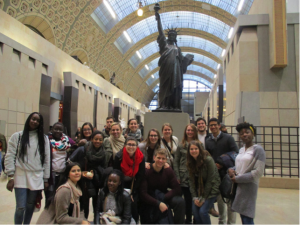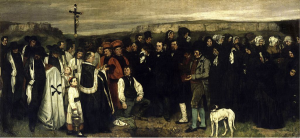Benjamin Elliott ’18

Before this semester, the last art class I took was in junior high, if I remember correctly. I’d never seen myself as particularly artsy, anyway – I’ve never graduated beyond the stick figure school of drawing, I was 15 the last time I seriously played an instrument, and I’ve always taken more solace in the works of Cormac McCarthy than those of Pablo Picasso.
While I wouldn’t say that I’m a budding art buff by any means, I’ve been shown in these last few months how wrong I was to have dismissed an entire discipline of art for so long. I’ve found a joy and a rich history in painting that I hadn’t previously known. There is a certain facet of human expression that is captured best by paintings, I realize now.
Below are three of the paintings that most impressed me throughout my travels in Paris, two from the Musée d’Orsay and one from the Louvre. All thanks to the Givens family for the scholarship that made the trip possible.


I think my favorite aspect of this particular work is the fact that it necessitates an explanation. I came to this particular tableau after wandering through many other galleries of the wonderful Musée d’Orsay in Paris, including some of the seminal works of the Impressionist movement. Indeed, it felt almost tucked away, but then I came into the room with it. A picture doesn’t quite do it justice – this thing is big.
But why bother? It’s a decidedly banal scene, for all intents and purposes. In Courbet’s era, paintings of this size were intended for scenes of import – Biblical scenes, old Greek legends, historical touchstones, and the like. And then we have this somber, grey scene with markedly normal people. Artists, quite simply, did not paint scenes like this at such a scale, if at all, if they wanted to make a name for themselves.
It is for precisely that decision that I was struck by this painting. It took courage to take the time to paint a scene such as this in Courbet’s day. In doing so, he helped to shape the Realist movement of his time, as well as later movements like Impressionism that took the time to capture the quotidian.
Quite honestly, I could have chosen any of Monet’s paintings I saw while on my trip in Paris. While learning about French art history this semester, I fell in love with the Impressionists, and Claude Monet above all other’s. There is a certain elegance to the Impressionist style and a realness that supersedes any other movements I’ve studied.
This is truer for Monet’s works than any other’s. The range of colors with which he paints here is breathtaking. He, above any other painter I saw in the Musée d’Orsay’s Impressionist gallery, was able to capture the exact colors I imagine one would see if they were to travel to this same field. Monet once said he wanted to paint the way a bird sings, and in viewing this, I’d have to say he got darn close.
I was impressed by this piece for several reasons. It’s extremely well done, and the way the light illuminates the scene throws everything into sharp contrast. The man shown in this painting is Jean-Paul Marat, a casualty of the French Revolution and the resultant Terror in which he took part. He was murdered for his role in the short-lived regime.
To begin, the figure of Marat himself is idealized. The man had a rather bad skin condition, which necessitated daily baths in the tub in which he has been painted in this scene. For what appears to be a pretty serious stab wound, also, there is not too much blood. Finally, the way his arm drapes out of the tub is reminiscent of Caravaggio’s Entombment of Christ — an artist who inspired David. The parallels between Christ in that painting and Marat here clearly suggest martyrdom of this revolutionary.
It is in that declaration I find myself fascinated by this painting. It became quite quickly after its unveiling a piece of propaganda for the Montagnards who presided over the terror – Maximilien Robespierre included. It speaks volumes about who these people thought they were, and how they comported themselves. For such a short-lived, tumultuous reign, the Montagnards were resolute to the point of death for their cause, which is impressed on me when I view this painting.
